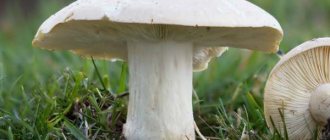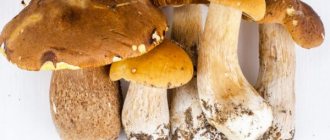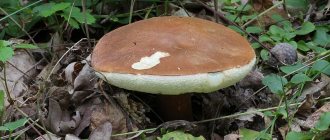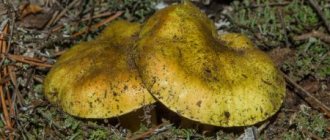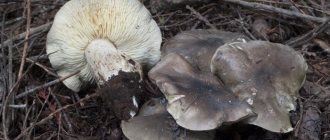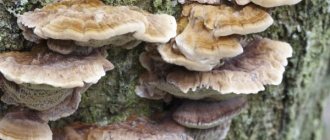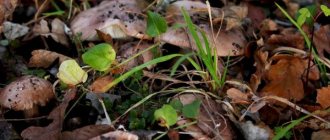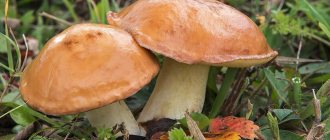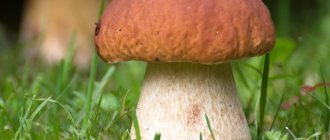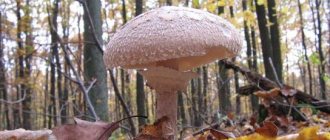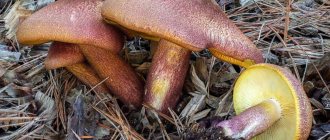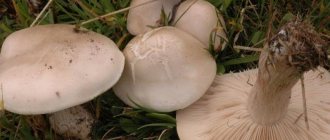Where do tiger rows grow?
Tiger row (tricholoma pardinum) can be found in any area with a temperate climate. Mushrooms grow on calcareous soils. They can form mycorrhizae with different trees, but more often they choose conifers. Sometimes they grow one at a time, without forming large groups.
In Russia, tiger rowers are common in the central regions with a temperate climate. Small colonies called “witch rings” are often found. Mushroom glades can be found in mixed and deciduous forests, on sandy soil. Poisonous specimens choose places under pine, spruce, and oak trees.
The fruits appear in August and do not disappear until mid-October. If the weather is favorable, growth extends until November. Tiger row is found in parks, gardens, fields and meadows.
Witches rings
An interesting and attractive picture can be found while walking through the forest. The rows seemed to be lined up in a circle for a round dance, and inside such a circle there was no grass. People say that all this is because of witches. Mushrooms sprout in the witch's magic circle, where she conducts her rituals with spells and dashing dances. There is an opinion that a witch hides a treasure in this place, which is why grass does not grow there. The mysterious appearance of this phenomenon gives rise to many legends. But this phenomenon is easily explained from a scientific point of view. Fungal spores germinate into the mycelium, which is where the fruiting body of the fungus develops. From the spore, the mycelium spreads to the sides, in a circle, this explains why mushrooms grow like that. The mycelium lives very little, after which it rots. Due to the fact that it needs a lot of nutrients, all the green flora inside the circle simply cannot compete with it. Every year, due to lack of nutrition, the mycelium dies, and the circle expands by 10-15 centimeters.
Swedish legend says that the culprits of such circles are elves. Little people play mischief at night and trample the grass. Approaching them is dangerous as a person can get sick.
In Holland, shepherds were forbidden to graze their cattle in such circles, as they believed that devils churned butter here at night. And if a cow enters it, the milk will disappear forever.
Author: Tatyana Smitskaya
What do tiger rows look like?
Photos and descriptions of tiger row allow one to recognize this mushroom among many others. It has a pleasant taste, unlike the taste of other poisonous specimens, so not all mushroom pickers immediately recognize it.
The hat is small in size - up to 12 cm in diameter. In a young mushroom, its shape is semicircular, and then takes on the appearance of a bell. In adulthood, the cap is flat. Its color can range from gray-white to asphalt gray. The tiger rowa has scaly growths, which gives it a tiger color.
The stem of the mushroom is quite long (up to 15 cm) and dense, its diameter does not exceed 3.5 cm. Its color is white. The shape is cylindrical, with an extension at the bottom. Old mushrooms have a smooth stem, while young mushrooms have a slight fibrous stem.
The plates under the cap are thick. Their color can vary from yellowish to greenish-white. On mature plates, a discharge of watery “dew” can be seen.
The pulp of the fruit is hard and gray. After trimming, the color remains the same. The product tastes pleasant and is not bitter. And the aroma is mealy, which is inherent in rows. The spores are medium in size and ellipsoidal in shape. The mass of the powder is white.
Purple dog
Peziza violacea belongs to the genus Peziza or Peziza and the family Pezizaceae or Pezizaceae. The fruiting bodies of the violet arctic fox grow in relatively large groups in areas after fires and bonfires. Peak fruiting occurs in spring and the first half of summer.
Characteristics and morphological description of mushrooms called purple petitsa:
- cup- or saucer-type discomycete;
- the average diameter of the shallow fruiting body is about 5-30 mm;
- the smooth inner part of the spore-bearing surface is lilac, violet or reddish-violet in color;
- the outer part is paler than the inner side, grayish-lilac or pale brown;
- the presence of a false pedicle may be observed;
- pale lilac color, rather thin and brittle pulp, does not have a pronounced mushroom taste and aroma.
The mushroom does not belong to the category of poisonous, but is collected by lovers of “quiet” hunting and is used for food purposes extremely rarely, due to the lack of decent taste and thick, fleshy pulp. Petsitsa is the closest relative of strings and morels, therefore it is used not only fried and salted , but also as a decoration for salads, which will significantly enrich the aesthetic side of ready-made dishes.
How to distinguish tiger row mushrooms
Tiger row is easily confused with its edible counterparts from this family. During harvesting, you should carefully inspect the mushrooms. The poisonous specimen has a silver-gray cap with a bluish tint, dotted with dark scales, and a powdery coating can be seen on the stem.
The following species are similar to the tiger row:
- Earthy. This is a small mushroom, there are no yellow or green shades on the back of the cap, the flesh is not characterized by the aroma of flour. The fruits are dark gray in color, but without a blue tone. The mushroom is edible, but not everyone likes its taste.
- Gray. There are no scales on the cap. This species is edible and suitable for all types of processing. Collection season: from September to the end of November.
- Black-scaled. The mushroom has dark scales, the cap is not wrapped around the edges. Its leg is light, but turns black towards the base. The mushroom is rare, there is no data on toxicity.
- Reddish. The scales of the fruit are dark brown, and the plates have a pinkish or reddish tint. The mushroom is edible and common in Crimea.
If you have doubts about the edibility of a mushroom when going to the forest, it is advisable not to take it. It is difficult for uninformed people to determine whether a fruit is safe. You shouldn't taste it. Before cooking, you need to carefully sort through the mushrooms again. But at home, it is much more difficult to determine edibility, because mushrooms crumple in the basket and break.
Cooking recipes
After the mushroom is well cooked, it becomes suitable for consumption in any form. It can be pickled, fried, added to soup, etc. Let's look at the simplest cooking methods.
Fried mushrooms
When the mushrooms are cooked, put the frying pan on the fire and add vegetable oil. Place the mushrooms in a single layer in the pan. Fry them over medium heat for 10 minutes. To prevent the fruit bodies from burning, they must be stirred periodically with a spatula. After 10 minutes of frying, you need to salt the mushrooms and add spices (optional). Then turn the heat to low and simmer the mushrooms for another 3-4 minutes. To improve the taste, you can add onions to the mushrooms (fry them together or in a separate frying pan).
Symptoms of poisoning
Important! Tiger rower is able to lure with its pleasant aroma and taste.
A person may not determine that the fruit is dangerous. The time when the first signs appear depends on the portion eaten and the general condition of the person. Symptoms usually appear within 15 minutes, but can linger for up to two hours. Digestive upset occurs even if a small amount is eaten.
When consuming brindle row, the following is likely to occur:
- severe vomiting;
- painful sensations in the stomach and intestines;
- severe diarrhea.
Dehydration occurs and a desire to drink arises. I am worried about severe abdominal pain and weakness. Sometimes a person loses consciousness. Symptoms persist for several hours. Recovery with timely measures taken lasts from 4 to 6 days.
There have been cases of liver damage. The toxin leads to severe inflammation of the mucous membranes of the stomach and intestines. If you do not consult a doctor promptly, it can be fatal. Even if poisoning is suspected, the help of a specialist is needed.
Danger to humans
The panther fly agaric is a poisonous mushroom. Its chemical composition contains substances harmful to human health:
- muscarine and muscaridine: alkaloids that cause general intoxication;
- scopolamine: an alkaloid that blocks the normal activity of brain cells, reduces motor activity and has a hypnotic effect;
- Hyoscyamine: an alkaloid that causes hallucinations and confusion.
Such substances are found in the chemical composition of poisonous herbs, such as henbane and datura.
The alkaloid hyoscyamine, discovered in the panther fly agaric, is similar in structure and in its effects on the eyes and heart to atropine. When poisoned with this compound, a person may develop a number of problems, including photophobia and hallucinations. There is also a high risk of coma and death.
At the same time, the aqueous extract of the panther fly agaric can be used to kill flies, because it has insecticidal properties. At the same time, it is important to ensure that pets and small children do not get to it - it is characterized by high toxicity.
First aid for poisoning
Tiger grass poisoning is life-threatening. It’s easier not to eat mushroom dishes than to put yourself at risk. If an inedible specimen ends up on a plate and a person becomes ill after eating it, first aid must be provided.
If you are poisoned by tiger grass, you must urgently rinse your stomach with a manganese solution. You should take any sorbent available in the first aid kit (activated carbon, Ensoral, Enterosorb). If dangerous symptoms appear, you need to call an ambulance.
Gastric lavage can also be performed with saline solution. Several procedures are necessary, but it is better not to refuse medical care.
You will need to undergo examination and tests. After poisoning, medications are prescribed for detoxification. Then they begin to treat any complications that have arisen.
If the poison has led to disruption of the kidneys, heart, blood vessels, restorative treatment and adherence to a dietary diet will be required. The patient will need to eat light food for several weeks, because the gastrointestinal tract suffers the most during poisoning.
Amethyst lacquer
An edible, but quite rare mushroom in our country called lilac or amethystina, from the Latin Laccaria amethystina, belongs to the genus Lakovitsa and the family Rowaceae. The mushroom grows on moist soils of forest zones and has the following external characteristics:
- the diameter of the cap varies between 10-50 mm;
- young specimens have a hemispherical shape;
- old fruiting bodies of amethyst varnish have a flat cap;
- the coloring of the surface of the cap is lilac-violet, but with age it is prone to strong fading;
- the plates are quite thick, sparsely spaced, lilac-violet in color;
- in mature specimens of fruiting bodies, the plates are whitish-powdery and descending along the stalk;
- leg with longitudinal fibers, characteristic purple coloring;
- The pulp is thin, lilac-violet in color.
Mushrooms can be used to prepare both first and second mushroom dishes.
Mushroom therapy, reality or advertising?
About 20 years ago, Japanese biology professor Goro Chihara announced that he knew a drug that could stop cancer. These are shiitake mushrooms growing on trees. The biologist argued: these mushrooms work on a new principle. They do not destroy tumor cells, but force the body to produce perforin (an enzyme that it produces specifically to fight cancer cells that form every day). Thus, it is possible to destroy tumors without introducing any poisons into the body.
Goro-san confirmed this clinically: the use of the Shiitake drug caused complete regression of the sarcoma.
Mushrooms from Japan have gained enormous “authority” on the American continent. The famous singer Michael Jackson drank shiitake tea every morning, praising its extraordinary healing properties and referring to it as a means of immortality.
American singer Madonna Louise Ciccone advertises these mushrooms for the freshness and elasticity of her skin. What is described above is more likely half true and half show.
However, in the West they began to intensively develop fungotherapy, investing heavily in the study of tree mushrooms from Japan (shiitake, meitake, reishi).
Distribution and collection
The species in question has a widespread distribution within the temperate climate zone. It is found in Europe, Asia, and the USA. The mushroom grows on a woody substrate of deciduous species. It is found both in the forest and within the city. Also grows in river valleys.
It bears fruit in the middle zone from mid-summer to mid-autumn, and in the southern regions - from mid-spring.
